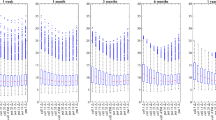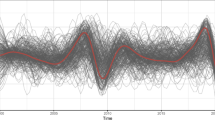Abstract
This paper studies the traditional local volatility model and proposes: A novel local volatility model with mean-reversion process. The larger is the gap between local volatility and its mean level, the higher will be the rate at which local volatility will revert to the mean. Then, a B-spline method with proper knot control is applied to interpolate the local volatility matrix. The bi-cubic B-spline is used to recover the local volatility surface from this local volatility matrix. Finally, empirical tests show that the proposed mean-reversion local volatility model offers better prediction performance than the traditional local volatility model.
Similar content being viewed by others
References
Keynes M J, The General Theory of Employment, Interest and Money, Macmillan Cambridge University Press, New York, 1936.
Cecchetti S, Lam P S, and Mark N, Mean reversion in equilibrium asset prices, The American Economic Review, 1990, 80: 398–418.
Black F, Mean reversion and consumption smoothing, Review of Financial Studies, 1990, 3: 107–114.
Bessembinder H, Coughenour J, Seguin P, and Smoller M M, Mean reversion in equilibrium asset prices: Evidence from the futures term structure, Journal of Finance, 1995, 50: 361–375.
Engle R and Patton A, What good is a volatility model?, Quantitative Finance, 2001, 1: 237–245.
Bouchouev I and Isakov V, The inverse problem of option pricing, Inverse Problems, 1997, 13: L11.
Dupire B, Pricing with a smile, Risk, 1994, 7: 18–20.
Sepp A, Pricing barrier options under local volatility, Mail: artursepp@hotmail.com,Web: www.hot.ee/seppar, 2002.
Coleman T, Li Y, and Verma A, Reconstructing the unknown local volatility function, Journal of Computation Finance, 1999, 2: 77–100.
Crépey S, Calibration of the local volatility in a generalized black-scholes model using TIKHONOV regularization, SIAM Journal of Mathematical Analysis, 2003, 34: 1183–1206.
Bernard D, Fleming J, and Whaley R, Implied volatility functions: Empirical tests, Journal of Finance, 1998, 53: 2059–2106.
Bedendo M and Hodges S, The dynamics of the volatility skew: A kalman filter approach, Journal of Banking and Finance, 2009, 33: 1156–1165.
Harker M, Least squares surface reconstruction from measured gradient fields, IEEE Conference on Computer Vision and Pattern Recognition, 2008, 1–7.
Catmuli E and Clark J, Recursively generated B-spline surfaces on arbitrary topological meshes, Journal of Computer-Aided Design, 1978, 10: 350–355.
Schoenberg J I, Contributions to the problem of approximation of equidistant data by analytic functions, Quarterly of Applied Mathematics, 1946, 4: 45–99.
Lee E T Y, A simplified B-spline computation routine, Computing, 1982, 29: 365–371.
Schoenberg J I, Cardinal interpolation and spline functions, Journal of Approximation Theory, 1969, 2: 167–206.
Carl D B, A Practical Guide to Splines, Springer-Verlag, New York, 1978.
Schumaker L, Spline Functions: Basic Theory, Wiley, New York, 1981.
Brunet P, Increasing the smoothness of bicubic spline surfaces, Computer Aided Geometric Design, 1985, 2: 157–164.
Vasicek O, An equilibrium characterisation of the term structure, Journal of Financial Economics, 1977, 5: 177–188.
Yang H, Wang W, and Sun J, Control point adjustment for B-spline curve approximation, Computer-Aided Design, 2004, 36: 639–652.
Park H, B-spline surface fitting based on adaptive knot placement using dominant columns, Computer-Aided Design, 2011, 43: 258–264.
Przemyslaw K, Bicubic B-spline blending patches with optimized shape, Computer-Aided Design, 2011, 43: 133–144.
Kineri Y, Wang M, Lin H, and Maekawa T, B-spline surface fitting by iterative geometric interpolation/approximation algorithms, Computer-Aided Design, 2012, 44: 697–708.
Ncube M, Stochastic Models and Inferences for Commodity Futures Pricing, Florida State University, 2009.
Bollerslev T, Generalized autoregressive conditional heteroskedasticity, Journal of Econometrics, 1986, 31: 307–327.
Hansen P and Lunde A, A forecast comparison of volatility models: Does anything beat a GARCH (1,1)?, Journal of Applied Econometrics, 2005, 20: 873–889.
Poon S H and Granger W J C, Forecasting volatility in financial markets: A review, Journal of Economic Literature, 2003, XLI: 478–539.
Author information
Authors and Affiliations
Corresponding author
Additional information
This paper was recommended for publication by Editor WANG Shouyang.
Rights and permissions
About this article
Cite this article
Zhou, S., Wang, H., Yen, J. et al. Bi-cubic B-spline fitting-based local volatility model with mean reversion process. J Syst Sci Complex 29, 119–132 (2016). https://doi.org/10.1007/s11424-015-3066-8
Received:
Revised:
Published:
Issue Date:
DOI: https://doi.org/10.1007/s11424-015-3066-8




